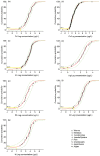Ecological Risk Assessment of Heavy Metals in Water Bodies around Typical Copper Mines in China
- PMID: 32560327
- PMCID: PMC7345622
- DOI: 10.3390/ijerph17124315
Ecological Risk Assessment of Heavy Metals in Water Bodies around Typical Copper Mines in China
Abstract
In order to understand the heavy metal pollution status and ecological effect in aquatic environment around copper mine areas, seven heavy metals (Cd, Cd, Cr, Cu, Hg, Zn, the Ni, and Pb) in aquatic environments in seven representative copper mine regions were selected from the literature in 2005-2013 for ecological risk assessment by using potential ecological risk index, geoaccumulation index, nemerow index and species sensitivity distribution method (Potential Affected Fraction (PAF) and Multi-Substance PAF (MSPAF)). The results of sediment ecological risk analysis showed that Cd, Cu and Pb were the main pollutants in sediments. The results of species sensitivity distribution analysis showed that the HC5 values (Hazardous Concentration for 5% of species) of seven heavy metals were different with order Zn > Cr > Cd > Pb > Cu > Ni > Hg. The MSPAF of seven copper mines in the following order with species sensitivity distribution method was as follows: Dabaoshan (99%) = Dahongshan (99%) = Baiyin (99%) > Dexing (97%) > Jinchuan (92%) > Tongling (39%) > Daye (24%). This study analyzes the impact of copper mining on the aquatic environment, and the results of this study will be great value for the comprehensive pollution governance of mining.
Keywords: copper mine; ecological risk; heavy metal; species sensitivity distribution.
Conflict of interest statement
The authors declare no conflict of interest.
Figures




Similar articles
-
[Spatial Variation of Heavy Metals in Soils and Its Ecological Risk Evaluation in a Typical Carya cathayensis Production Area].Huan Jing Ke Xue. 2018 Jun 8;39(6):2893-2903. doi: 10.13227/j.hjkx.201707115. Huan Jing Ke Xue. 2018. PMID: 29965648 Chinese.
-
Multi-phase distribution and comprehensive ecological risk assessment of heavy metal pollutants in a river affected by acid mine drainage.Ecotoxicol Environ Saf. 2017 Jul;141:75-84. doi: 10.1016/j.ecoenv.2017.03.009. Epub 2017 Mar 19. Ecotoxicol Environ Saf. 2017. PMID: 28319862
-
[Sources, pollution statue and potential ecological risk of heavy metals in surface sediments of Aibi Lake, Northwest China].Huan Jing Ke Xue. 2015 Feb;36(2):490-6. Huan Jing Ke Xue. 2015. PMID: 26031074 Chinese.
-
[Spatial distribution and ecological risk assessment of heavy metals in the estuaries surface sediments from the Haihe River Basin].Huan Jing Ke Xue. 2013 Nov;34(11):4204-10. Huan Jing Ke Xue. 2013. PMID: 24455925 Chinese.
-
Risk Assessment and Source Identification of Toxic Metals in the Agricultural Soil around a Pb/Zn Mining and Smelting Area in Southwest China.Int J Environ Res Public Health. 2018 Aug 25;15(9):1838. doi: 10.3390/ijerph15091838. Int J Environ Res Public Health. 2018. PMID: 30149620 Free PMC article.
Cited by
-
Evaluation of Remote Sensing Ecological Index Based on Soil and Water Conservation on the Effectiveness of Management of Abandoned Mine Landscaping Transformation.Int J Environ Res Public Health. 2022 Aug 8;19(15):9750. doi: 10.3390/ijerph19159750. Int J Environ Res Public Health. 2022. PMID: 35955105 Free PMC article.
-
A sustainability assessment-based methodology for the prioritization of contaminated site risk management options.Environ Sci Pollut Res Int. 2022 Jan;29(5):7503-7513. doi: 10.1007/s11356-021-15911-1. Epub 2021 Sep 2. Environ Sci Pollut Res Int. 2022. PMID: 34476702
-
On Psalmopoeus Pocock, 1895 (Araneae, Theraphosidae) species and tarantula conservation in Ecuador.Zookeys. 2023 Dec 13;1186:185-205. doi: 10.3897/zookeys.1186.108991. eCollection 2023. Zookeys. 2023. PMID: 38312860 Free PMC article.
-
A Remote-Sensing Ecological Index Approach for Restoration Assessment of Rare-Earth Elements Mining.Comput Intell Neurosci. 2022 Jul 14;2022:5335419. doi: 10.1155/2022/5335419. eCollection 2022. Comput Intell Neurosci. 2022. PMID: 35875751 Free PMC article.
-
Recent Progress on the Adsorption of Heavy Metal Ions Pb(II) and Cu(II) from Wastewater.Nanomaterials (Basel). 2024 Jun 16;14(12):1037. doi: 10.3390/nano14121037. Nanomaterials (Basel). 2024. PMID: 38921913 Free PMC article. Review.
References
-
- Wu J., Li J., Teng Y., Chen H., Wang Y. A partition computing-based positive matrix factorization (PC-PMF) approach for the source apportionment of agricultural soil heavy metal contents and associated health risks. J. Hazard. Mater. 2020;388:121766. doi: 10.1016/j.jhazmat.2019.121766. - DOI - PubMed
-
- Zhou Q., Yang N., Li Y., Ren B., Ding X., Bian H., Yao X. Total concentrations and sources of heavy metal pollution in global river and lake water bodies from 1972 to 2017. Glob. Ecol. Conserv. 2020;22:e00925. doi: 10.1016/j.gecco.2020.e00925. - DOI
-
- Aslam S., Chan M.W., Siddiqui G., Boczkaj G., Kazmi S.J., Kazmi M.R. A comprehensive assessment of environmental pollution by means of heavy metal analysis for oysters’ reefs at Hab River Delta, Balochistan, Pakistan. Mar. Pollut. Bull. 2020;153:110970. doi: 10.1016/j.marpolbul.2020.110970. - DOI - PubMed
Publication types
MeSH terms
Substances
LinkOut - more resources
Full Text Sources

